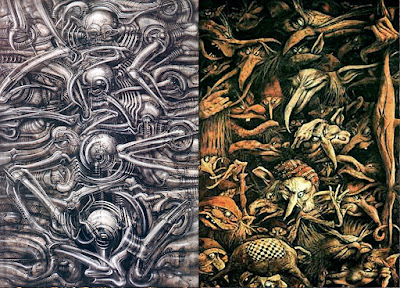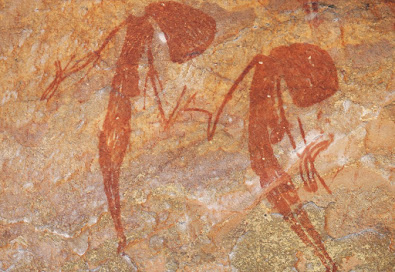leading from
 |
| HR Giger's Biomechanical Landscape (work 312) acrylic on paper on wood (200cm x 140cm) |
a) Main vision of the painting
I have been a fan of the compact quality of Giger's Biomechanical Landscape with its strange goblin heads with near enough insect like limbs interlinking limbs of locusts and the slide rods of train wheels and other machinery, and these creatures are imbedded within the machinery and have become merged with it.
As it goes further down, the goblin head at the top becomes more and more a piece of machinery at the bottom, and Giger describes these things as warheads.
Perhaps the picture displays the qualities of an assembly plant with multiple mechanical arms and the warheads running through the centre perhaps are on a conveyor belt obscured by all the ribbing and mechanisms.
Source quotes
b) Australian Petroglyphs
First of all I was able to identify references to Australian rock art in the painting, looking at the way some of these limbs interrelated with one another in a way that reminded me of the petroglyphs
c) Ernst Fuch's Triumph of the Unicorn
A few months later I noticed the top half of Ernst Fuch's composition Triumph of the Unicorn resembled the structure of Giger's painting and since Giger had a great interest in Fuch's work, it seemed likely enough that this was a starting point.
d) Brian Froud's Faeries illustration (1978) echoes HR Giger's Biomechanical Landscape (1976)
I thought about how goblin like the heads in Giger's painting seemed, I wondered about Brian Froud because I recalled some pieces of art where he has filled the painting with heads and limbs and noticed one of the Brian Froud illustrations for Faeries published two years later in 1978. The central heads almost forming a row from top to bottom are highlighted amongst the other heads and limbs of the various goblins. A question comes to the surface about how long has this piece by Froud been around on show before it was published, had Froud had seen Giger's work. or is it just a vague coincidence
I have been a fan of the compact quality of Giger's Biomechanical Landscape with its strange goblin heads with near enough insect like limbs interlinking limbs of locusts and the slide rods of train wheels and other machinery, and these creatures are imbedded within the machinery and have become merged with it.
As it goes further down, the goblin head at the top becomes more and more a piece of machinery at the bottom, and Giger describes these things as warheads.
Perhaps the picture displays the qualities of an assembly plant with multiple mechanical arms and the warheads running through the centre perhaps are on a conveyor belt obscured by all the ribbing and mechanisms.
Source quotes
- HR Giger: Work no. 312, Biomechanoid Landscape, 1975, (200 x 140 cm), belongs to the Art Collection Zurich, Switzerland. It is one of the two paintings, of which a copy is shown at the Museum H.R. Giger, because it is very difficult to obtain original painting on loan for expositions. The painting represents, at its best, the biomechanical style of my paintings; bones and electronic devices transformed into warheads at the center of painting, arranged in a row from top to bottom. This painting is, indeed, ideal for the design of a skateboard.(http://www.hrgiger.com/boards.htm)
b) Australian Petroglyphs
First of all I was able to identify references to Australian rock art in the painting, looking at the way some of these limbs interrelated with one another in a way that reminded me of the petroglyphs
c) Ernst Fuch's Triumph of the Unicorn
A few months later I noticed the top half of Ernst Fuch's composition Triumph of the Unicorn resembled the structure of Giger's painting and since Giger had a great interest in Fuch's work, it seemed likely enough that this was a starting point.
 |
| Upper half of Ernst Fuchs' Triumph of the Unicorn (1952) and HR Giger's Biomechanical Landscape (work 312) |
I thought about how goblin like the heads in Giger's painting seemed, I wondered about Brian Froud because I recalled some pieces of art where he has filled the painting with heads and limbs and noticed one of the Brian Froud illustrations for Faeries published two years later in 1978. The central heads almost forming a row from top to bottom are highlighted amongst the other heads and limbs of the various goblins. A question comes to the surface about how long has this piece by Froud been around on show before it was published, had Froud had seen Giger's work. or is it just a vague coincidence
 |
| compare HR Giger's Biomechanical Landscape to an illustration from Brian Froud's Faeries |
d) Giger's Lifecycle Hieroglyphics borrows from his earlier Biomchanical Landscape (work 312)
Seeing this painting posted at Fantastic Art on Facebook together with Giger's Life Cycle Hieroglyphics for the Alien production on 2nd December 2016, suddenly made me realise that the two paintings had a connection in that Giger appeared to used elements of this Biomechanics landcape paintings structure of the Hieroglyphic paintin



No comments:
Post a Comment